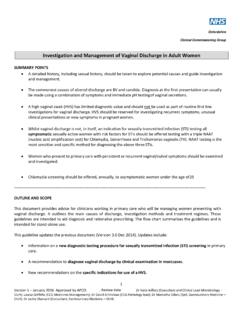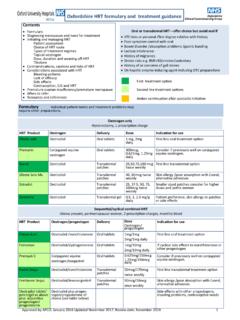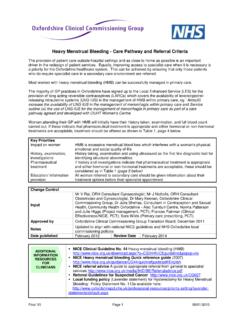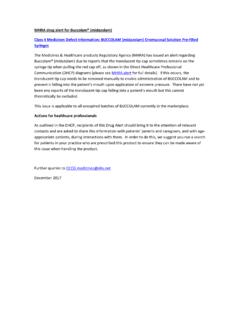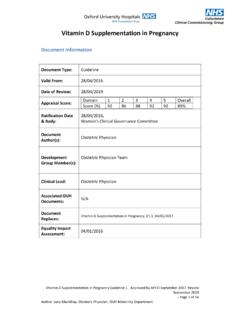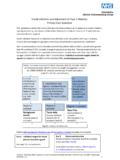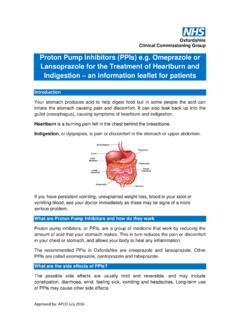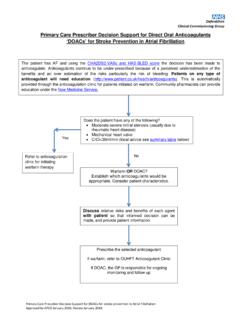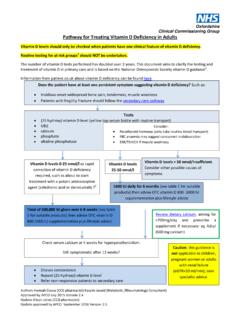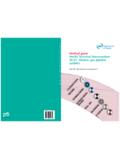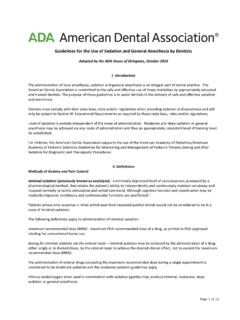Transcription of Good Practice Guidance D: Medicine administration records ...
1 Oxfordshire Clinical Commissioning Group Date produced: May 2011; Reviewed April 2013; Date for Review: May 2015 good Practice Guidance documents are believed to accurately reflect the literature at the time of writing. However, users should always consult the literature and take account of new developments because these may affect this Guidance 1 good Practice Guidance D: Medicine administration records (MAR) in Care Homes Adapted from the CQC Professional Advice: Medicine administration records (MAR) in care homes and domiciliary care QMP Document No 124-08 which has now been withdrawn. Key Points Care home staff who give medicines must have a chart that details: which medicines are prescribed for the resident when they must be given what the dose is any special information, such as giving the medicines with food. The medicines chart should be signed when they are given as individual doses or full packs if the person self-administers.
2 It is also important to keep a record when prescribed Medicine has not been given, if codes are used these should be explained on the medicines chart and not be the same as staff initials. administration of controlled drugs should be recorded on the person s medicines chart as well as the record in the controlled drug (CD) register. Ideally medicines chart should be printed but if a handwritten medicines chart is the only option, there must be a robust system to ensure it is correct before it is used. The medicines chart must be kept up-to-date which may mean changing the MAR chart by hand. Care homes should have a robust system to check the source and accuracy of any such changes. Medicines cannot be prescribed on a medicines chart as they are only a record of what has been administered; any medicines prescribed have to be on a prescription forms.
3 Oxfordshire Clinical Commissioning Group Date produced: May 2011; Reviewed April 2013; Date for Review: May 2015 good Practice Guidance documents are believed to accurately reflect the literature at the time of writing. However, users should always consult the literature and take account of new developments because these may affect this Guidance 2 What do the regulations say? The Care Quality Commission document: Guidelines about compliance; essential standards of quality and safety gives Guidance on what providers should do to comply with regulations of the Health and Social Care Act 2008. It states that providers should have effective procedures for medicines handling including arrangements for recording when medicines are given. This should include: what is received what is currently prescribed (including those self-administering medicines) what is given by care home staff what is disposed of Why is the MAR chart so important?
4 Care home staff who give medicines must have a chart that details: which medicines are prescribed for the resident when they must be given what the dose is any special information, such as giving the medicines with food. This information is included in the NHS prescription that the pharmacist or dispensing doctor keeps when the Medicine is dispensed. The care home must have a record of medicines currently prescribed for that person. These should be signed when they are given as individual doses or full packs if the person self-administers. It is also important to keep a record when prescribed Medicine has not been given. Letter codes are often used to record when medicines have not been given and the reason why. The MAR must explain what the codes mean and these must not be the same as staff signatures or initials. The information on the MAR will be supplemented by the resident s care plan.
5 The care plan will include personal preferences, including ethnic issues such as should the care home member of staff who gives the medicines be the same sex as the person. The MAR can be a very useful tool for the care home to use to keep track of medicines that are not ordered every month but only taken occasionally. The care home may use the MAR to record tablets carried over onto a new chart. The MAR can be used to record when non-prescribed medicines are given, for example a homely remedy. Further information is available in the Oxfordshire CCG guideline The use of homely remedies in care homes (with and without nursing). Oxfordshire Clinical Commissioning Group Date produced: May 2011; Reviewed April 2013; Date for Review: May 2015 good Practice Guidance documents are believed to accurately reflect the literature at the time of writing.
6 However, users should always consult the literature and take account of new developments because these may affect this Guidance 3 administration of controlled drugs should be recorded on the person s MAR chart as well as the record in the controlled drug (CD) register. Further Guidance on controlled drugs is available in the good Practice Guidance C: The safe management of controlled drugs in Care Homes . Responsibility for providing MAR charts rests with the care home. The pharmacist or dispensing doctor are not responsible for providing these. Can the care home ask the GP to sign the MAR charts? A GP does not have to sign any documents produced by a care home for Medicine administration . The NHS contract for general medical services (GMS) does not require this. There are exceptions for example if a care home has a private contract with a GP for medical services that exceed GMS and this is included within the contract.
7 There are some occasions when it would be appropriate to ask the GP to sign the MAR chart, for example when the doctor visits and changes the dose of a prescribed Medicine . Do care homes have to use printed MAR charts? Poor records are a potential cause of preventable medication errors. Printed MAR charts are not essential but they are recommended as they are better than handwritten charts as there is less risk of error due to: clerical error - incorrectly transcribing the details from another document handwriting that is difficult to read and can be misunderstood. Example 1 The change of insulin dose for a resident was communicated verbally to staff and then hand written onto the MAR. The instruction was to give 4 units of insulin at night. The nurse who took the message wrote 4 on the chart ( is an abbreviation for international units), but another nurse misread the dose and gave 41 units of insulin.
8 Refer to the National Patient Safety Agency alerts on insulin and the good Practice Guidance 1: Use of insulin in Care Homes for further information. However, if a handwritten MAR is the only available option, there must be a robust system to check that the MAR is correct before it is used. Printed MAR charts are usually supplied from the pharmacy or dispensing doctors Practice when medicines are packaged in monitored dosage systems such as Manrex, Venalink and Nomad. This is a complimentary service that the supplier is paying for. Care homes cannot insist on having printed charts and there may be a charge to the care home for supplying printed MAR charts. Oxfordshire Clinical Commissioning Group Date produced: May 2011; Reviewed April 2013; Date for Review: May 2015 good Practice Guidance documents are believed to accurately reflect the literature at the time of writing.
9 However, users should always consult the literature and take account of new developments because these may affect this Guidance 4 Are there known problems associated with printed MAR charts? Yes, there are problems that the care home needs to be alert to: The chart is correct at the time it is printed and supplied. However the dose of a Medicine may change at some point. When this happens, the care home must keep the chart up to date. New prescriptions can be issued at any time in the monthly cycle. This may result in the person having several MAR charts in a file, and some may start on different dates. Medicines that are prescribed for as required use may not be needed every month. If the MAR only has a list of medicines that have been requested and prescribed that month, it may not list the as required medicines previously supplied for that person.
10 The MAR should be supplemented by information that clearly describes the circumstances when as required Medicine may safely be given. The MAR may include a Medicine that has not been supplied. The care home must check whether the prescriber has stopped the Medicine and if so cross it off the chart, date and sign. If the treatment is to continue, the care home must check why there is no supply. Can anyone write on the printed MAR? Anyone can change the MAR chart, but the care home should have a system to check the source and accuracy of the changes. A cross reference to the daily notes is recommended. When a resident s medication is altered, care home staff are responsible for amending the MAR: cancel the original direction write the new directions legibly and in ink on a new line of the MAR write the name of the doctor or other prescriber who gave the new instructions date the entry, print your name and sign that you have written on the MAR chart where possible, get a second accredited member of staff to print their name and sign that they have checked the entry ensure that handwriting is clear and can be read easily take extra care when writing strengths and doses to make sure they cannot be misunderstood see Example 1 above The dosage as directed is not appropriate and should be clarified with the GP or pharmacist.
